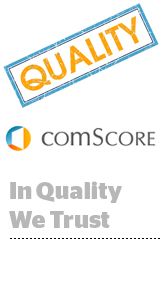 comScore is making a foray into the world of inventory quality analysis.
comScore is making a foray into the world of inventory quality analysis.
The measurement company, known for its validated Campaign Essentials (vCE) product and Media Metrix planning tool, announced Thursday that it’s going to make viewability, non-human traffic certifications and publisher rankings available via programmatic trading platforms with the launch of what it’s calling “Trust Profiles.”
comScore customers will be able to access the profiles via MediaMath, Turn, The Trade Desk, Rubicon and Eyereturn Marketing in Q1. Other SSPs and DSPs will be added throughout 2015.
Part of the industry’s viewability issue ties back to the lack of trust between buyers and sellers. The promise of programmatic may be efficiency, but many publishers are saving their cream inventory for the direct buys, leaving the less than stellar remainder to the automated systems.
“We want to help create an efficient market,” said comScore COO Cameron Meierhoefer. “A safe place where marketers can execute successful marketing plans that are impactful and sellers don’t expect to get the same value for above-the-fold inventory as below-the-fold inventory, though they know that they can get the full value when it makes sense.”
“In a way, we’re trying to pull off a trust exercise between buyers and seller,” he said.
There’s no reason to believe that digital inventory won’t be fully traded by programmatic mechanisms in the relatively near future – and that fundamentally changes the relationship between ad planners and publishers, Meierhoefer said.
“It’s not going to be a planner buying a web page, it’s going to be algorithms making decisions in the moment,” he said. “So this information – human traffic, brand safety, in-view – has to be surfaced in a programmatic way so that it’s available at decision time.”
That’s because quality – and its independently verified quantification – is part of what’s holding the industry back from a more generally transparent marketplace. Rather than 100% viewability, the goal should be 100% transparency. For example, there could be some value to an advertiser in buying below-the-fold inventory with a 40% or 50% viewability rate – if the inventory is packaged, priced and presented to buyers accordingly so that they can make informed purchase decisions.
Meierhoefer also noted that some publishers are still holding back their best inventory from the programmatic ecosystem because they don’t trust that they’ll be able to maximize its value if it’s being sold in the same way as its less-than-stellar stuff.
“There is value in all things and it’s not our job to decide – that’s between the buyer and the seller,” he said. “That’s why transparency, the security of inventory identity and control over how things are packaged and rendered are so critical for this to work. That’s also why we’re starting out our focus here on the publisher. But we do need to measure everyone the same way so the market can function.”
AdExchanger Daily
Get our editors’ roundup delivered to your inbox every weekday.
Daily Roundup
But what does this mean for companies like Forensiq, Integral Ad Science or DoubleVerify?
“We’ll always need the independent players, but they’re focused on viewability, pre-bid, verification, non-human traffic, etc. – and we do all of that, as well, but we also provide the media-planning metrics that everyone wants to see,” said comScore CEO Serge Matta. “We’re not just focused on viewability, but also on more holistic metrics. For example, if I make this bid, will my uniques increase? Will this bid give me an increase in engagement or increase my reach?”
In other words, viewability on its own is less handy than viewability plus context.
“We believe that potentially two or three years from now, viewability could become a commodity,” Matta said. “It’s in the best interests of the Atlases and DoubleClicks of the world to prove the quality of their service to their clients. It’s still early days, but it’s not crazy to think that everyone will have viewability scores embedded in some way, perhaps through the ad server.”
Although comScore seems convinced that a greater focus on quality will help solve the current viewability problem, Neal Mohan, Google’s VP of display and video advertising, sees it the other way around.
“As an industry, we should address viewability, but then move onto things like, ‘Was this even the right set of human beings that saw my ads?’ and ‘What was the impact on my brand as a result of my campaign?’” Mohan told AdExchanger in an earlier interview. “We can’t get to any of those questions around [quality] if we have lingering doubt around viewability.”
In other news, comScore has been quite busy this week. The company announced an update to its Video Metrix on Monday that would allow the tool to also measure mobile, tablet and over-the-top consumption.













